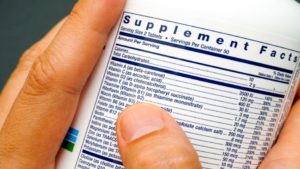Ever walk down the supplement aisle at your local health-food store and feel overwhelmed by all the different options and the sheer quantity of supplements available? You're not alone!
These days there seems to be a dizzying number of supplements offering practically any nutrient you can think of, from vitamins and minerals to probiotics and amino acids. While that can be a boon to your health, it can also be a headache trying figure out which supplement is right for you. But you don’t have to feel like you’re reading a foreign language when looking at supplement labels any longer. Here’s how to decode the Supplement Facts labels so you know exactly what you’re getting.
Supplements Soaring in Popularity
Over the last couple of decades, supplement use has seen a steady increase with multivitamins, calcium, protein, and vitamin D leading the pack. 2 According to the National Center for Health Statistics, from 2007–2008 to 2017–2018, the use of dietary supplements among American adults rose from 48.4 percent to 56.1 percent. Women tend to be more likely to make them a part of their daily regimen than men do (63.8 percent to 50.8 percent). And almost one-quarter of adults aged 60 and over report taking four or more dietary supplements.1 With stats like these, it’s no wonder that the global dietary supplement market was valued at more than $150 billion in 2021!3
Flashy Labels
When you’re in the market for a supplement, it can be difficult to determine if a product is any good by just looking at the label on the front. That’s because the bright and flashy front labels are often splashed with marketing techniques designed to get you to buy a company’s products. Claims like “#1 Doctor Recommended,” “Advanced Formula,” or “High Absorption” all sound good but they are subjective and don’t necessarily mean that a product will work for you. Instead, it’s the back label that you should be focusing on.

How to Review the Supplement Facts Label
Every dietary-supplement company is required to place a Supplement Facts label on their product. And all Supplement Facts labels must include some basic info. The FDA mandates that five statements be listed:4
- The name of the dietary supplement
- The serving size and servings per container
- The quantity of each nutrient
- A full and accurate list of ingredients
- The name and place of business of the manufacturer, packer, or distributor
A good place to start is with the serving size. Usually the first thing listed on the Supplement Facts label, this will let you know how much you should take to get a full dose.
Then you’ll want to pore over the nutrients listed. Depending on what type of supplement you’re looking at, this may be a single item or a laundry list. A basic magnesium supplement will typically only contain magnesium. But a multivitamin will list dozens of nutrients.
To the right of these nutrients, you’ll see the quantity of each nutrient, usually presented in grams (g), milligrams (mg), or micrograms (mcg), as well as the Percent Daily Value (%DV). This tells you what percentage of your daily need of a particular vitamin or mineral is provided in the supplement, based on the average 2,000-calorie diet. If a product contains 25% of the DV for a certain nutrient, say calcium, then that means the supplement will supply 25% of your daily recommended calcium, and you should get the remaining 75% from other sources, ideally from the foods you eat. Oftentimes, supplements will offer much more than 100% of the Daily Value.
What Else to Look For
In addition to those basic requirements, there are a few more items to consider:
Suggested usage. Even though the serving size will be listed under Supplement Facts, that may not be the amount that you’ll be recommended to take. Be sure to look for the “suggested use” instructions to get an idea of how many times per day you’ll need to take a particular supplement for maximinum benefit.
Other Ingredients. These are typically the ingredients used to bind the nutrients together so that they’re consumable. Cellulose, gelatin, magnesium stearate, calcium carbonate, silicon dioxide are common to see in this section.
If you are vegan or vegetarian, you’ll want to pay special attention to these additional ingredients. Unless it says otherwise, you can bet that many of them are animal based. Most capsules are made of gelatin, which is derived from animal body parts. But other animal byproducts can fly under the radar, too. With names such as pepsin, lipase, collagen, glycerin, they can be easy to miss.
Free of. Some supplements won’t just tell you what’s in them; they may also tell you what’s not. From “no artificial flavors” to “gluten free,” these claims can be listed anywhere on the packaging. Manufacturers may also warn that, even though foods such as wheat, gluten, soy, milk, egg, fish or shellfish are not used in the supplement, trace levels may be present due to their being produced in the same facility. This is critical info if you have food allergies.
There are certain symbols to look out for as well. The letter “K” in a triangle signifies that it’s kosher. “Non-GMO” means that a product doesn’t use genetically modified ingredients. And “DNA Sequencing Verified” indicates that a probiotic supplement’s bacterial strains have been confirmed.
Ingredient names. Most ingredients are pretty easy to identify, whereas others can be a bit more tricky. For instance, vitamin C could be listed as ascorbic acid or ascorbate. And then there are probiotics, which typically have not only two names but also a strain code: for instance Lactobacillus (genus) gasseri (species) KS-13 (strain code). While these differences may seem minor on the surface, they can mean the difference between getting the relief you’re expecting and wasting your money.
For example, Bifidobacterium longum MM-2 helps manage cholesterol as opposed to Bifidobacterium longum BB536, which support gut immunity.5 6 And since researchers have identified nearly 8,000 of unique bacterial strains in the gut microbiome, it’s important to know which one you’re getting.7
When buying a probiotic, it’s also smart to check the number of CFUs (colony-forming units) it contains. This tells you how many beneficial bacteria you’re getting in each dose. Most doses range from 1 to 10 billion CFUs that you take once or twice a day. Also look for “guaranteed live at expiry” so that you know the probiotics will be viable all the way through the supplement’s shelf life.
CGMP compliance. Current Good Manufacturing Practices, or CGMPs, are standards set by the US Food and Drug Administration (FDA), and all dietary-supplements makers are required to adhere to them.8 These rules cover every aspect of supplement production, from the raw materials, facilities, and equipment to the training and personal hygiene of employees. These regulations ensure that a product is safe for use and that it provides the ingredients and efficacy it claims to provide.9
Certifications. Some supplements are endorsed by a third-party group, such as NSF International, the US Pharmacopeial Convention (USP), or ConsumerLab.com. These organizations perform independent analyses to certify that what’s on the label is in the bottle. Typically, these include toxicology and contamination tests to ensure the product your purchasing is safe and doesn’t contain any ingredients not listed on the packaging.
Best by date. This one is obvious but it bears acknowledging. Make sure to check that your supplement will still be good by the time you intend to use it; otherwise it may lose its potency and its effectiveness.
Keep In Mind
There’s one more thing you’re sure to notice. Somewhere on the packaging you’ll see the advisory “these statements have not been evaluated by the Food and Drug Administration.” Remember that the FDA regulates dietary supplements as food, not as drugs. In fact, supplement companies don’t have to provide FDA with the evidence it relies on to substantiate safety before or after marketing its products.10 Rather, the companies are responsible for ensuring that the dietary supplements it manufactures or distributes are not adulterated or misbranded.
Do Some Digging
Aside from scrutinizing the label itself, it’s also smart look into the manufacturer. While you might be drawn to a certain product for its purported benefits, don’t just take the label’s word for it. Do a quick Google search and check out the manufacturer’s website. Quality supplement manufacturers will highlight the science behind their ingredients and their finished products. This includes randomized, double-blind, placebo-controlled human trials, which are considered the gold standard in research.
Supplement shopping can be overwhelming. But with a little knowledge of what to look for and how to decipher the ingredients, you’ll be able to translate a Supplements Facts label with ease.
References
- Suruchi M. “Dietary Supplement Use Among Adults: United States, 2017–2018.” NCHS Data Brief No. 399. 2021.
- Kamiński M. Determination of the Popularity of Dietary Supplements Using Google Search Rankings. Nutrients. 2020;12(4):908.
- Grand View Research. “Dietary Supplements Market Size, Share & Trends Analysis Report By Ingredient (Vitamins, Minerals), By Form, By Application, By End User, By Distribution Channel, By Region, And Segment Forecasts, 2022–2030.” 2022. https://www.grandviewresearch.com/industry-analysis/dietary-supplements-market.
- U.S. Food & Drug Administration. “Dietary Supplement Labeling Guide: Chapter I. General Dietary Supplement Labeling.” 2005. https://www.fda.gov/food/dietary-supplements-guidance-documents-regulatory-information/dietary-supplement-labeling-guide-chapter-i-general-dietary-supplement-labeling.
- Spaiser SJ. Lactobacillus gasseri KS-13, Bifidobacterium bifidum G9-1, and Bifidobacterium longum MM-2 ingestion induces a less inflammatory cytokine profile and a potentially beneficial shift in gut microbiota in older adults: a randomized, double-blind, placebo-controlled, crossover study. Journal of the American College of Nutrition. 2015;34(6):459-69.
- Wong CB. Beneficial effects of Bifidobacterium longum subsp. longum BB536 on human health: Modulation of gut microbiome as the principal action. Journal of Functional Foods. 2019;54:506-519.
- Poyet M. A library of human gut bacterial isolates paired with longitudinal multiomics data enables mechanistic microbiome research. Nat Med. 2019;25:1442–52.
- U.S. Food & Drug Administration. “Small Entity Compliance Guide: Current Good Manufacturing Practice in Manufacturing, Packaging, Labeling, or Holding Operations for Dietary Supplements.” 2020. https://www.fda.gov/drugs/pharmaceutical-quality-resources/current-good-manufacturing-practice-cgmp-regulations.
- U.S. Food & Drug Administration. “Current Good Manufacturing Practice (CGMP) Regulations.” 2020. https://www.fda.gov/drugs/pharmaceutical-quality-resources/current-good-manufacturing-practice-cgmp-regulations.
- U.S. Food & Drug Administration. “Questions and Answers on Dietary Supplements.” 2022. https://www.fda.gov/food/information-consumers-using-dietary-supplements/questions-and-answers-dietary-supplements.
This article is for informational purposes only. This article is not, nor is it intended to be, a substitute for professional medical advice, diagnosis, or treatment and should never be relied upon for specific medical advice.

Share this Post